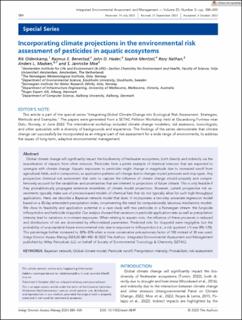| dc.contributor.author | Oldenkamp, Rik | |
| dc.contributor.author | Benestad, Rasmus | |
| dc.contributor.author | Hader, John D. | |
| dc.contributor.author | Mentzel, Sophie | |
| dc.contributor.author | Nathan, Rory | |
| dc.contributor.author | Madsen, Anders L. | |
| dc.contributor.author | Moe, S. Jannicke | |
| dc.date.accessioned | 2024-04-19T11:22:56Z | |
| dc.date.available | 2024-04-19T11:22:56Z | |
| dc.date.created | 2023-11-08T08:50:39Z | |
| dc.date.issued | 2023 | |
| dc.identifier.citation | Integrated Environmental Assessment and Management. 2023, 20 (2), 384-400. | en_US |
| dc.identifier.issn | 1551-3777 | |
| dc.identifier.uri | https://hdl.handle.net/11250/3127429 | |
| dc.description.abstract | Global climate change will significantly impact the biodiversity of freshwater ecosystems, both directly and indirectly via the exacerbation of impacts from other stressors. Pesticides form a prime example of chemical stressors that are expected to synergize with climate change. Aquatic exposures to pesticides might change in magnitude due to increased runoff from agricultural fields, and in composition, as application patterns will change due to changes in pest pressures and crop types. Any prospective chemical risk assessment that aims to capture the influence of climate change should properly and comprehensively account for the variabilities and uncertainties that are inherent to projections of future climate. This is only feasible if they probabilistically propagate extensive ensembles of climate model projections. However, current prospective risk assessments typically make use of process-based models of chemical fate that do not typically allow for such high-throughput applications. Here, we describe a Bayesian network model that does. It incorporates a two-step univariate regression model based on a 30-day antecedent precipitation index, circumventing the need for computationally laborious mechanistic models. We show its feasibility and application potential in a case study with two pesticides in a Norwegian stream: the fungicide trifloxystrobin and herbicide clopyralid. Our analysis showed that variations in pesticide application rates as well as precipitation intensity lead to variations in in-stream exposures. When relating to aquatic risks, the influence of these processes is reduced and distributions of risk are dominated by effect-related parameters. Predicted risks for clopyralid were negligible, but the probability of unacceptable future environmental risks due to exposure to trifloxystrobin (i.e., a risk quotient >1) was 8%–12%. This percentage further increased to 30%–35% when a more conservative precautionary factor of 100 instead of 30 was used. | en_US |
| dc.language.iso | eng | en_US |
| dc.publisher | Wiley | en_US |
| dc.rights | Navngivelse-Ikkekommersiell 4.0 Internasjonal | * |
| dc.rights.uri | http://creativecommons.org/licenses/by-nc/4.0/deed.no | * |
| dc.title | Incorporating climate projections in the environmental risk assessment of pesticides in aquatic ecosystems | en_US |
| dc.type | Peer reviewed | en_US |
| dc.type | Journal article | en_US |
| dc.description.version | publishedVersion | en_US |
| dc.rights.holder | © 2023 The Authors | en_US |
| dc.source.pagenumber | 384-400 | en_US |
| dc.source.volume | 20 | en_US |
| dc.source.journal | Integrated Environmental Assessment and Management | en_US |
| dc.source.issue | 2 | en_US |
| dc.identifier.doi | 10.1002/ieam.4849 | |
| dc.identifier.cristin | 2193629 | |
| dc.relation.project | Meteorologisk institutt: 181090 | en_US |
| cristin.ispublished | true | |
| cristin.fulltext | original | |
| cristin.qualitycode | 1 | |

